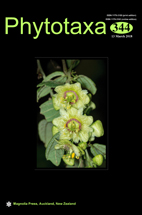Abstract
The Atlantic Forest, known for its high biodiversity and endemism levels, now reduced to about 7% of its original area (Myers et al. 2000, Oliveira-Filho & Fontes 2000, Ribeiro et al. 2009), is the main center of diversity for Griffinia Ker Gawler (1820: t. 444). The genus is represented by about sixteen species (Preuss 1999, Campos-Rocha 2015, Campos-Rocha et al. 2017), the majority considered threatened with extinction (MMA 2014). Griffinia is morphologically characterized by having usually pseudopetiolate leaves with reticulate venation, bluish or sometimes white zygomorphic flowers with a hypanthium of variable length, and whitish globose seeds lacking phytomelanin in the testa and with an elaiosome. Currently, it is divided into two subgenera, Griffinia, and Hyline (Herbert 1840: t. 3779) Ravenna (1969: 63), with several ecological and morphological differences (Preuss 1999, Campos-Rocha 2015), though they may not constitute monophyletic groups (Meerow et al. 2000). Subgenus Griffinia, with about fourteen small to large-sized species, are generally understory plants of the Atlantic Forest, with pseudopetiolate leaves and bluish or occasionally white flowers. Subgenus Hyline has two recognized species of the understory of Cerrado and Caatinga primarily, with fragrant and ephemeral large white flowers, rarely pink (Preuss 1999, Campos-Rocha 2015). Griffinia, together with the monotypic genus Worsleya Traub (1944: 89), constitute a strongly supported clade (Meerow et al. 2000), tribe Griffinieae Ravenna (1974: 65), the only Amaryllidaceae tribe endemic to Brazil.

